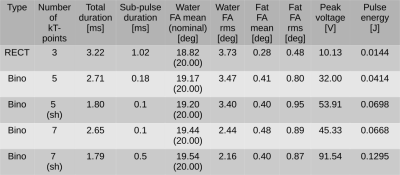0781
Interleaved Binomial kT-Points for Water-Selective Imaging at 7T1German Center for Neurodegenerative Diseases (DZNE), Bonn, Germany, 2Department of Physics and Astronomy, University of Bonn, Bonn, Germany
Synopsis
Achieving homogeneous fat suppression is important for a wide range of MRI applications. In this work, we present time-efficient water-selective, parallel transmit RF excitation pulses for ultra-high field applications. This method combines the properties of kT-points with water-selective binomial pulses to achieve short, B1 insensitive water excitation pulses.
Introduction
Homogenization of the image contrast plays a key role at ultra-high field (7T). Different approaches have been proposed and parallel transmission (pTx) has turned out to be particularly effective. However, the combination of pTx homogenization and spectral selective excitation increases the pulse duration and therefore limits the echo and/or the repetition time of fast steady-state imaging sequences.To achieve high image homogeneity and spectral selection while maintaining short RF-pulse durations, we propose interleaved binomial kT-points pulses. The basic approach is similar to the work described in [1] but extended to dynamic pTx pulses, leveraging the full potential of multichannel transmission.
Methods
Image homogenization was achieved by employing non-selective kT-points pulses [2]. To introduce water-selection into kT-points, we applied the concept of binomial (1-1) pulses [3].The most obvious approach is to repeat the kT-points pulse when fat and water protons are out of phase to tip the fat magnetization back to the longitudinal axis, see Figure 1 (middle: binomial classic). If the total pulse length is longer than half the precession period of fat (Tfat/2) the second pulse has to be applied at an odd multiple of Tfat/2 later, leading to overly long pulse durations and significantly increased B0 sensitivity. However, due to the composite nature of kT-points, the pulse can be split into sub-pulse blocks shorter than Tfat/2: The first sub-pulse block is repeated directly after Tfat/2, immediately followed by the second sub-pulse block played out in the same fashion, and so forth (Figure 1 bottom).
For comparison, a previously published kT-points based water excitation technique was implemented [4,5]. Here, each sub-pulse duration is adjusted to suppress fat (~1ms at 7T), see Figure 1 (top: RECT). Therefore , the only degree of freedom is the number of kT-points, leading to a compromise between homogenization and total RF-pulse duration.
Bloch simulations of the interleaved binomial kT-points pulse were carried out and compared to the RECT pulse by means of duration, homogeneity, fat suppression, peak voltage and pulse energy.
The pulse design was implemented on a MAGNETOM 7T scanner (Siemens AG, Healthcare Sector, Erlangen, Germany). For validation, in vivo MPRAGE data were acquired, using a head array coil with 32 receive and 8 transmit channels (Nova Medical, Wilmington, USA) using simple CP mode pulses and kT-points pulses (7 sub-pulses) without and with water-selectivity. Imaging parameters: TI = 1100 ms (adiabatic CP-based inversion), TE/TR: 4.4 / 2500 ms, turbofactor 176, 1mm3 isotropic resolution. The sequence utilizes an optimized linear reordering scheme with elliptical scanning and 2D parallel imaging (CAIPI 2x2z1) [6].The total scan time was 2:40 min.
Results
Simulation results of a few selected example pulses are listed in Table 1. In order to get a good compromise between water-selection and homogenization for the RECT water excitation, the number of kT-points was chosen to be 3, as in [5], resulting in 3.22ms total duration.The interleaved binomial kT-points pulses were optimized to obtain shorter total durations. This was achieved by varying the number of kT-points and the sub-pulse duration. If shorter binomial sub-pulse durations were used, the number of kT-points could be increased and hence better homogeneity was achieved, while still maintaining shorter total pulse durations. However, shorter sub-pulses increase peak voltages and total energies.
Fig. 2 shows flip angle maps of a phantom slice calculated in Bloch simulations for water (top) and fat (bottom) using representative pulses from Table 1. For the fat simulation, the B0 map was shifted to the fat frequency to simulate a “fat-only” phantom. Using the proposed interleaved binomial kT-points pulses, the mean fat flip angle increases only slightly compared to the RECT kT-points pulse, while water is excited more homogeneously.
The effectiveness of interleaved binomial kT-points pulses could be demonstrated in vivo and is shown in Fig. 3. The images acquired in CP mode (top) clearly lack intensity in the cerebellum whereas the interleaved kT-points pulse achieves good homogeneity. Additionally, the fat signal is effectively suppressed for the interleaved binomial kT-points pulses (bottom right), as predicted by the Bloch simulations.
Discussion/Conclusion
In this work, we demonstrate a time efficient combination of B1-homogenization and water excitation for ultra-high field applications. In contrast to the RECT kT-points method, interleaved binomial kT-points add another degree of freedom to the pulse design to obtain good image homogeneity even with short water-selective pulses. SAR can be controlled by choosing appropriate sub-pulse durations and number of kT-points.Future prospects include the extension to binomial 1-2-1 or higher order binomial pulses, which are less sensitive to B0 inhomogeneities, and thus lead to more robust fat suppression.
Acknowledgements
No acknowledgement found.References
[1] Malik S. J. et al.: MRM 2010;63:988-997
[2] Cloos M. A. et al.: MRM 2012;67:72–80
[3] Hore P. J.: JMR 1983;54:539-542
[4] Stirnberg R., et al: MRM 2016;76:1517-1523
[5] Le Ster C., et al. PLoS ONE 2019;14:e0225286
[6] Brenner, D, et al. Magma (New York, N.Y.), 27(5), 455–462.
Figures

Figure 1: A comparison of different water excitation schemes. Top: RECT kT-point excitation as used in [5]. Middle: “Classical” binomial 1-1 excitation applied to kT-points pulses. The second pulse starts at an odd number of half phase cycles of fat. Bottom: Proposed interleaved version of the 1-1 binomial kT-points pulse.

Table 1: Simulation results of different water-selective pulses. Type “RECT” is a simple rectangular kT-points water excitation pulse [4,5]. “Bino” is the proposed interleaved binomial kT-points pulse. (sh) means shorter sub-pulse duration.

Figure 2: Resulting flip angle maps from Bloch simulations at water (a) and fat (b) resonance frequency for the example pulses shown in Table 1. For the fat simulation the B0 map was shifted to the fat frequency.
